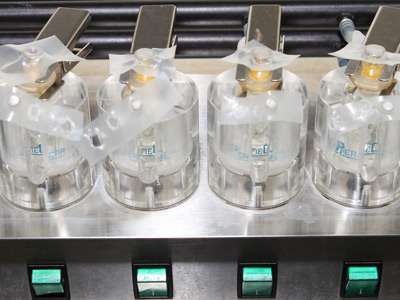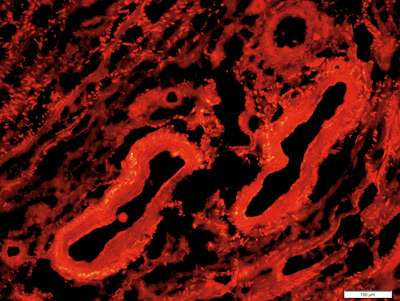Compounds now used in the treatment of early-stage breast cancer and novel compounds developed at SDSU are being tested using pig breast tissue on this bank of nine receptacles.
One of every eight women in the United States will develop breast cancer. Though the incidence of breast cancer began decreasing in 2000, it is still the second-leading cause of cancer death in women.
Better screening techniques, increased awareness and improved treatments have increased the 5-year survival rate to nearly 100 percent for women with early-stage cancer.
In 2013, an estimated 65,000 women were diagnosed with carcinoma in situ, a non-invasive breast cancer that affects the milk ducts and lobules of the breast, according to the American Cancer Society.
While nearly everyone diagnosed at this stage can be cured, professor Om Perumal, head of the pharmaceutical sciences department, points out that the side effects from the drugs used to combat this disease are pretty significant.
Doctoral student Kaushalkumar Dave puts a buffer solution into the receiving compartment. Any drug that passes through the nipple will be captured in this buffer.
He and doctoral student Kaushalkumar Dave are developing a new method to deliver cancer-fighting drugs directly to the milk ducts, where more than 95 percent of breast cancer originates. The patent pending technology has been licensed to Tranzderm Solutions, a Brookings-based start-up company. Perumal is the company's chief scientific officer.
This method promises to reduce side effects and to deliver large doses of medication directly to the affected tissues. The research has been supported by the Translational Cancer Center, one of the 2010 South Dakota Governor's Research Centers. It provides seed money for high-risk, high-reward research.
Using this data, Perumal has teamed with researchers and clinicians from Johns Hopkins University and Mayo Clinic to apply for an $800,000 Department of Defense grant.
Delivering drugs through milk ducts
Anti-cancer drugs, such as tamoxifen, are normally administered through an oral tablet, so the medication must travel through the bloodstream before reaching the breast tissue, explains Perumal.
Side effects of tamoxifen, for example, include increased risk of uterine cancer, cataracts, stroke and cardiovascular disease. Patients diagnosed with precancerous cells or lesions may take tamoxifen anywhere from three months to five years.
This microscope image shows the distribution of a fluorescent dye in the nipple ducts in the pig breast tissue section.
These significant side effects may be mitigated through a more direct, localized drug delivery method, according to Perumal.
The researcher proposes applying a medication-containing gel or lotion to the nipple. The drug will then be absorbed through openings in the nipples directly into the milk ducts.
When the project began, Perumal thought that breast anatomy was well understood, "but it's not," he explains. The number of openings in the nipple varies based on the individual, but the range is usually 10 to 15 openings per nipple. The number of openings gives the scientists an indication of how much drug can be delivered.
Receiver vials are then stored and the amount of radioactive material measured so that professor Om Perumal and doctoral student Kaushalkumar Dave know how much of a specific drug compound can be absorbed through the openings in the nipple.
Next, the researchers looked at which molecules could be delivered. To do this, they used pig breast tissue. Surprisingly, they found that even large molecules, such as proteins, can be transported through these openings, making a wide range of medications deliverable.
Validating the model
Feedback from a proposal submitted to the National Institute of Health confirmed that the researchers needed to use human breast tissue to prove the feasibility of the pig model.
"Animal skin is usually thinner and more permeable than human tissue," Perumal explains. "We need repeatability." Pigs have on average six to seven pairs of mammary glands, but the team would needed at least three pairs of human breasts—at a cost of more than $700 per set—to validate the model.
Fortunately, Perumal was able to obtain the human breast tissue he needed free of charge through the Lions Eye and Tissue Bank in Sioux Falls. Director Marcy Dimond says her organization provides tissue to qualified South Dakota programs conducting medical research.
"We have a progressive medical community and being able to contribute to research programs that have the potential to be far-reaching is a wonderful opportunity," says Dimond. Not everyone can be a transplant donor, so this is a way those patients who truly want to be donors can contribute to research.
The donation of breast tissue was integral to advancing the project.
"Without them, we wouldn't have made a lot of progress," Perumal says. Having local access to tissues was "a big help to move things forward."
Documenting similar trends
Comparing the absorption rate of the nipple with the surrounding breast skin, twice the amount of drug can be delivered through the nipple, Perumal explains. "It's a direct port of entry." Plus, the medication does not enter the bloodstream.
Though different drug quantities are absorbed, pig and human breast tissue show similar trends, Perumal explains. As a result, the researchers can now use pig tissue to optimize and test various drug formulations. Dave, who will finish his dissertation within a year, has already begun some animal studies. He recently received a grant from Women and Giving at the SDSU Foundation to support his work.
A variety of compounds show promise in fighting the many types of breast cancer. Perumal points to a natural compound developed by former colleague and Distinguished Professor Emeritus Chandradhar Dwivedi to prevent skin cancer—as having the potential to prevent breast cancer.
Additional methods are also being used in Perumal's lab to increase the penetration of the compounds through the nipple. The successful studies in animals may lead to clinical testing in humans.
"If this approach is successful, the impact will be huge in terms of reducing side effects." says Perumal. Once perfected, this unique technology developed at SDSU will help improve the lives of women battling early-stage breast cancer.
Provided by South Dakota State University





















